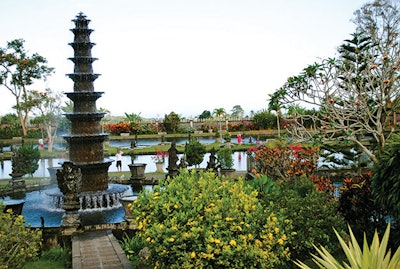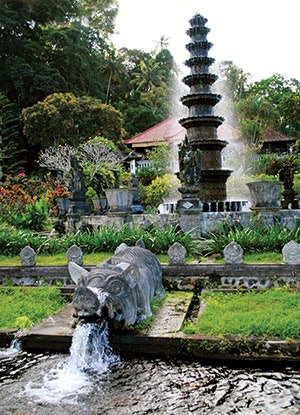


For those who love the artistic blend of water, gardens and architecture, Bali’s Imperial water temple known as Tirtagangga hits all the right notes with harmonic eastern flair.
Meaning “holy water of the Ganges,” Tirtagangga is located six miles from the town of Amlapur in a region defined by rice paddies, lush landscape, small villages and a culture of deep reverence for the life-giving power of water.
Tirtagangga was completed in 1946, built by Raja Karangsem, who was inspired by the religious rites of spring, the mild climate and especially the scenic beauty of the surrounding hills. He worked shoulder to shoulder with laborers constructing the site’s countless features.
The site covers 1.2 hectares (approximately 3 acres) and is still owned and maintained by Balinese royalty. It serves as a venue for numerous Hindu celebrations and rituals during which it is festooned with colorful flags, umbrellas and offerings.
The property is organized on three levels with water emerging from an abundant natural spring beneath a holy Banyan tree. From there, water flows down into multiple swimming pools, ponds and fountains depicting mythical creatures. After flowing through the landscape the water is released to irrigate surrounding rice paddies.
Among the scores of water features and sculptures, the most prominent is the Nawa Sanga Fountain, a spectacular 11-tiered water tower in the center of the complex. The overall design scheme features a blend of Indian and Chinese architecture and touches of European style in two swimming pools that echo the pools of Versailles. A world class collection of Koi swish through one of the ponds, which features stepping pads allowing visitors to cross the water and come in close contact with the colorful fish.
The property was almost lost in 1963 to the eruption of nearby Mount Agung, which lasted from February to September, inundating the property with ash. During that time it suffered looting and vandalism and was all but destroyed. Restoration took place slowly in the following years, funded largely by tourism and even continues to this day.











































